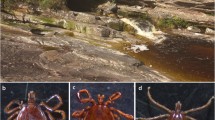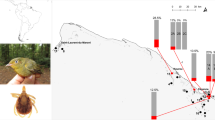Abstract
Background
Species of the genus Borrelia are causative agents of Lyme disease and relapsing fever. Lyme disease is the most commonly reported vector-borne disease in the northern hemisphere. However, in some parts of the world Lyme borreliosis and relapsing fever may be caused by novel Borrelia genotypes. Herein, we report the presence of a Borrelia sp. in an Amblyomma varanense collected from Python reticulatus.
Methods
Ticks were collected from snakes, identified to species level and examined by PCR for the presence of Borrelia spp. flaB and 16S rRNA genes. Phylogenetic trees were constructed using the neighbour-joining method.
Results
Three A. varanense ticks collected from P. reticulatus were positive for a unique Borrelia sp., which was phylogenetically divergent from both Lyme disease- and relapsing fever-associated Borrelia spp.
Conclusion
The results of this study suggest for the first time that there is a Borrelia sp. in A. varanense tick in the snake P. reticulatus that might be novel.
Similar content being viewed by others
Background
Tick infestation in snakes occurs worldwide and involves the following species: Amblyomma gervaisi in the northern region of western Ghats in India [1], Rhipicephalus sanguineus (sensu lato) in Malaysia [2], Amblyomma varanense and Amblyomma helvolum in Thailand [3, 4] and Amblyomma hydrosauri in Australia [5]. Hirunkanokpun et al. [6] detected several bacterial species in the national parks of Thailand, but no Borrelia spp. were found. The aim of this study was to determine the presence of Borrelia spp. within Amblyomma spp. ticks collected from five snake species. In addition, phylogenetic analyses of Borrelia spp. are also presented.
Methods
Tick collection and identification
Tick collection from snakes was performed in February 2014 in Lopburi Province, Thailand (14°48′1.61″N, 100°38′10.75″E). We observed snake scales to identify partial protrusions of tick bodies outside of the scales. Ticks were collected from the skin beneath the scales using forceps. Ticks were identified according to their morphology using standard taxonomic keys [7–11].
DNA extraction and amplification
The ticks were washed individually and homogenised in 200 μl of 10× PBS solution. DNA extraction was performed using the QIAamp® DNA Blood Mini Kit (Qiagen, Hilden, Germany). Oligonucleotide primer pairs FLA1-FLA2 (BflaPAD 5′-GAT CA(G/A) GC(T/A) CAA (C/T)A TAA CCA(A/T) ATG CA-3′; BflaPBU, nest- 5′-GCT GAA GAG CTT GGA ATG CAA CC-3′; BflaPCR, nest-5′-TGA TCA GTT ATC ATT CTA ATA GCA-3′; BflaPDU 5′-AGA TTC AAG TCT GTT TTG GAA AGC-3′) and 16S rDNA (16SF1 5′-ATA ACG AAG AGT TTG ATC CTG GC-3′; 16SR 5′-CAG CCG CAC TTT CCA GTA CG/3′) were used in this study to identify target Borrelia DNA in the ticks [7, 8]. The positive PCR products from tick samples were purified using a High Pure PCR product purification kit (Roche, Basel, Switzerland). Sequencing reactions were performed with BigDye Terminator v3.1 Cycle Sequencing Kits (Applied BioSystems, Waltham, Massachusetts, USA) based on the fluorescent-label terminator method. Sequencing products were analyzed using a Genetic Analyzer 3730XL automated DNA sequencing system (Applied BioSystems, Waltham, Massachusetts, USA).
Phylogenetic analysis
Phylogenetic trees were constructed using the neighbour-joining method (PAUP 4.0b1) [12]. DNA gaps or missing data were excluded from the analyses. Confidence values for individual branches of the resulting tree were determined by bootstrap analysis with 1000 replicates.
Results and discussion
Ticks were collected from the following five snake species: Python reticulatus, Ophiophagus hannah, Ptyas korros, Naja kaouthia and Elaphe radiata. Four Amblyomma varanense ticks (three males and one female) were collected from one P. reticulatus. One A. varanense tick (one female) and two Amblyomma pattoni (males) were collected from O. hannah. Two A. pattoni (males) were collected from N. kaouthia. In addition, two A. pattoni males were collected from E. radiata. Finally, one A. varanense tick (male) was collected from E. radiata. Tick species reported in this study have hypostomal dentition 3/3. The male of A. pattoni has coxa I with an inconspicuous internal spur, which is sometimes fused with the more prominent external spur, and cervical pits are comma-shaped. The male of A. varanense has coxa I with the external spur noticeably longer than the internal and the female has coxa I with the internal spur smaller than the external spur, but always separated from the latter (Fig. 1).
Pictures of ticks identified in this study. a Amblyomma pattoni, male, dorsal view. b Amblyomma pattoni, male ventral view. c Amblyomma varanense, male, dorsal view. d Amblyomma varanense, male, ventral view. e Amblyomma varanense, female, dorsal view. f Amblyomma varanense, female, ventral view. Scale-bars: 1 mm
A total of 12 ticks was collected from snakes and examined by PCR for the presence of the Borrelia spp. genes. Of these, three ticks, all identified as A. varanense isolated from P. reticulatus, were positive for Borrelia spp. No Borrelia spp. were detected in A. pattoni or in A. varanense collected from other snake species.
Borrelia sp. DNA sequences were compared with sequences in the NCBI GenBank database by nucleotide BLAST. The 16S rRNA gene sequence of this Borrelia sp. is 100 % identical (1449/1449 bp) to Borrelia sp. BF16 (GenBank: AB473538) and was submitted to GenBank and assigned as KU497718 (Borrelia sp. in Amblyomma varanense from Python reticulatus). The amplified PCR product of the flaB gene for flagellin was approximately 384 bp. A sequence analysis of the flaB gene for flagellin from the Borrelia-positive ticks revealed that this gene sequence is 99 % similar (294/296 bp) to a sequence for Borrelia sp. BF16 flaB gene for flagellin (isolate BF16; GenBank: AB473488). The 384 bp Borrelia flaB consensus sequence was submitted to GenBank and assigned as Borrelia sp. KT758064. By contrast, this sequence was only 87 % similar (337/387 bp) to the following: the B. turcica flaB gene for flagellin (strain IST4; GenBank: AB109244); B. turcica IST7 flagellin gene (GenBank: KF422815) (336/387 bp); and Borrelia sp. tAG66 M flaB gene for flagellin (GenBank: AB529322) (336/387 bp).
Phylogenetic trees were constructed using the neighbour-joining method (PAUP 4.0b1) [12]. Individual branch confidence values were determined by bootstrap analysis with 1000 pseudoreplicates (Figs. 2 and 3). The phylogenetic trees for both genes of Borrelia spp. inferred from the complete 16S rRNA gene sequences (Fig. 2) and partial sequences of the flaB genes (Fig. 3) indicated that Borrelia sp. from the present study is related to Borrelia sp. (GenBank: AB473538) from reptiles and to B. turcica IST7 (GenBank: KF422815) flagellin gene, respectively, but belongs in a different group from Borrelia burgdorferi. The phylogenetic relationships among relapsing fever-associated Borrelia spp. and Lyme disease-associated Borrelia spp. were reported previously using rrs and 16S rDNA [13, 14]. The flaB and 16S rRNA gene sequences of Borrelia sp. of A. varanense from P. reticulatus isolated in this study, formed a separate branching root from both Lyme disease-associated Borrelia species and relapsing fever-associated Borrelia species.
Conclusion
Our findings suggest that Borrelia sp. in A. varanense from P. reticulatus might be novel and phylogenetically divergent from both Lyme disease- and relapsing fever-associated Borrelia species.
References
Pandit P, Bandivdekar R, Geevarghese G, Pande S, Mandke O. Tick infestation on wild snakes in northern part of western Ghats of India. J Med Entomol. 2011;48:504–7.
Mariana A, Vellayan S, Halimaton I, Ho TM. Acariasis on pet Burmese python, Python molurus bivittatus in Malasia. Asian Pac J Trop Med. 2011;4:227–8.
Sumrandee C, Hirunkanokpun S, Doornbos K, Kitthawee S, Baimai V, Grubhoffer L, Trinachartvanit W, Ahantarig A. Molecular detection of Rickettsia species in Amblyomma ticks collected from snakes in Thailand. Ticks Tick Borne Dis. 2014;5:632–40.
Sumrandee C, Hirunkanokpun S, Grubhoffer L, Baimai V, Trinachartvanit W, Ahantarig A. Phylogenetic relationships of Francisella-like endosymbionts detected in two species of Amblyomma from snakes in Thailand. Ticks Tick Borne Dis. 2014;5:29–32.
Stenos J, Graves S, Popov VL, Walker DH. Aponomma hydrosauri, the reptile-associated tick reservoir of Rickettsia honei on Flinders Island, Australia. Am J Trop Med Hyg. 2003;69:314–7.
Hirunkanokpun S, Kittayapong P, Cornet JP, Gonzalez JP. Molecular evidence for novel tick-associated spotted fever group rickettsiae from Thailand. J Med Entomol. 2003;40:230–7.
Wodecka B. Detection of Borrelia burgdorferi sensu lato DNA in Ixodes ricinus ticks in North-western Poland. Ann Agric Environ Med. 2003;10:171–8.
Masuzawa T, Takada N, Kudeken M, Fukui T, Yano Y, Ishiguro F, et al. Borrelia sinica sp. nov., a Lyme disease-related Borrelia species isolated in China. Int J Syst Evol Microbiol. 2001;51:1817–24.
Robinson L. Ticks. A monograph of the Ixodoidea. Part IV. The genus Amblyomma. Cambridge: Cambridge University Press; 1926.
Kohls GM. Malaysian parasites. XVIII. Ticks (Ixodoidea) of Borneo and Malaya. Stud Inst Med Res Malaya. 1957;28:65–94.
Takano A, Goka K, Une Y, Shimada Y, Fujita H, Shiino T, et al. Isolation and characterization of a novel Borrelia group of tick-borne borreliae from imported reptiles and their associated ticks. Environ Microbiol. 2010;134–146.
Swofford DL. PAUP*. Phylogenetic analysis using parsimony (*and other methods). Version 4.0 beta10. Sunderland: Sinaneur Associates; 2002.
Ras NM, Lascola B, Postic D, Cutler SJ, Rodhain F, Baranton G, et al. Phylogenesis of relapsing fever Borrelia spp. Int J Syst Bacteriol. 1996;46:859–65.
Güner ES, Watanabe M, Hashimoto N, Kadosaka T, Kawamura Y, Ezaki T, et al. Borrelia turcica sp. nov., isolated from the hard tick Hyalomma aegyptium in Turkey. Int J Syst Evol Microbiol. 2004;54:1649–52.
Acknowledgement
This research project is supported by Mahidol University and a Higher Education Research Promotion grant (HERP, 2557A13162005).
Funding
This research project is supported by Mahidol University and a Higher Education Research Promotion grant (HERP, 2557A13162005).
Availability of data and material
The sequences for Borrelia sp. in Amblyomma varanense from Python reticulatus are submitted to the GenBank database under accession numbers KU497718 (16S rRNA) and KT758064 (flaB gene sequence).
Authors’ contributions
WT and AA planned and designed the study. WL and DB carried out the field collection of samples. WT and AA carried out the majority of the laboratory and tick identification work. SH performed the phylogenetic analysis. RS generated 16S rRNA gene sequences of Borrelia and helped in identification section. WT and AA wrote the manuscript with some advice from VB. All authors read, discussed, and approved the final version of the manuscript.
Competing interests
The authors declare that they have no competing interests.
Consent for publication
Not applicable.
Ethics approval and consent to participate
Not applicable.
Author information
Authors and Affiliations
Corresponding author
Rights and permissions
Open Access This article is distributed under the terms of the Creative Commons Attribution 4.0 International License (http://creativecommons.org/licenses/by/4.0/), which permits unrestricted use, distribution, and reproduction in any medium, provided you give appropriate credit to the original author(s) and the source, provide a link to the Creative Commons license, and indicate if changes were made. The Creative Commons Public Domain Dedication waiver (http://creativecommons.org/publicdomain/zero/1.0/) applies to the data made available in this article, unless otherwise stated.
About this article
Cite this article
Trinachartvanit, W., Hirunkanokpun, S., Sudsangiem, R. et al. Borrelia sp. phylogenetically different from Lyme disease- and relapsing fever-related Borrelia spp. in Amblyomma varanense from Python reticulatus . Parasites Vectors 9, 359 (2016). https://doi.org/10.1186/s13071-016-1629-8
Received:
Accepted:
Published:
DOI: https://doi.org/10.1186/s13071-016-1629-8







